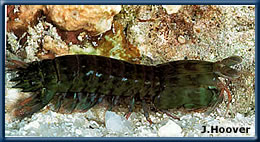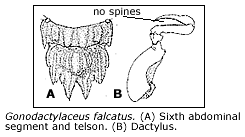

Balanus amphitrite

Balanus eburneus

Chthamalus proteus

Gonodactylaceus falcatus

Ligia exotica

Pachygrapsus fakaravensis

Scylla serrata
Gonodactylaceus falcatus
 Philippine
mantis shrimp
Philippine
mantis shrimp
Phylum Arthropoda
Subphylum Crustacea
Class Malacostraca
Order Stomatopoda
Family Gonodactylidae
Description
Individuals may grow to about 6 cm in length and are generally dark green
(males) or reddish brown (females). This species can be distinguished
from other Hawaiian stomatopods by examination of the last (sixth) abdominal
segment and telson (pictured below). The sixth abdominal segment has six
inflated carinae or lobes. The telson also with inflated carinae and three
pairs of marginal teeth and one pair of accessory teeth. Memebers of the
genus Gonodactylaceus do not have spines
on dactylus. Another smaller species, G. hendersoni,
is also found in Hawaii and is considered also to be introduced. It is
typically a mottled beige with some white spots.
 Habitat
Habitat
Dead branching coral heads, clumps of coralline algae, or crevices and
small holes in solid reef substrate.
Distribution
Hawaiian Islands
Shallow reefs of Oahu, especially Kaneohe Bay and Waikiki
Native Range
Indo-Pacific
Present Distribution
Indo-Pacific and Hawaiian Islands
Mechanism of Introduction
Unintentional, most likely with fouling on ships' hulls
Impact
An aggressive species, G. falcatus has been
shown to drive out the native stomatopod, Pseudosquilla
ciliata, from dead coral heads. Since it's introduction, G.
falcatus has almost completely replaced the once common P.
ciliata in the coral heads on the shallow reefs of Oahu (Kinzie,
1968).
Ecology
Feeding
Stomatopods are generally carnivorous predators, using their powerful
raptorial claws to snap up live prey.
Reproduction
Stomatopods have separate sexes. Fertilized eggs are carried by the female
until hatching. The free-swimming planktonic larvae undergo several stages
of development before settlement in shallow water. G.
falcatus appears to reproduce twice a year (see Kinzie, 1968)
Remarks
Kinzie (1968) argued that an lndo-Pacific species of mantis shrimp (which
he discussed under the name Gonodactylus falcatus)
was introduced to the Hawaiian Islands. Manning and Reaka (1981) subsequently
described the same Hawaiian population as a new species, Gonodactylus
aloha, and considered it endemic. Kinzie (1984) examined their
arguments in detail and concluded that at the least the species was cryptogenic.
Barber and Erdmann (2000) proposed that G. aloha
is a synonym of G. mutatus, but recently
Ahyong (pers. comm.) has synonymized G. mutatus
back to G. falcatus.
The first specimens of G. falcatus were observed
in 1954 in dead coral heads in Kaneohe Bay. Kinzie (1968) suggested that
it was introduced onto Oahu with concrete barges towed back at the end
of World War II, particularly from the area of the Philippines and the
South China Sea. Kinzie demonstrated experimentally that the more aggressive
G. falcatus had displaced the native stomatopod
Pseudosquilia ciliata from coral head habitats
in Kaneohe Bay. It's continued presence around Oahu has been reported
by a number of authors.
References
Barber, P.H. and M.E. Erdmann. 2000. Molecular systematics of the Gonodactilidae
(Stomatopoda) using mitochondrial cytochrome oxidase C (subunit 1) DNA
sequence data. J. Crust. Biol. 20: 20-36.
Kinzie, R.A. 1968. The ecology of the replacement of Pseudosquilla
ciliata by Gonodactylus falcatus (Crustacea: Stomatopoda) recently
introduced into the Hawaiian Islands. Pac. Sci. 22: 465-475.
Kinzie, R.A. 1984. Aloha also means goodbye: a cryptogenic stomatopod
in Hawaii. Pac. Sci. 38: 298-311.
Manning, R.B. and M.L. Reaka. 1981. Gonodactylus
aloha, a new stomatopod crustacean from the Hawaiian Islands. J.
Crust. Biol. 1: 190-200.
© 2002 Hawaii Biological Survey, Bishop Museum
contact